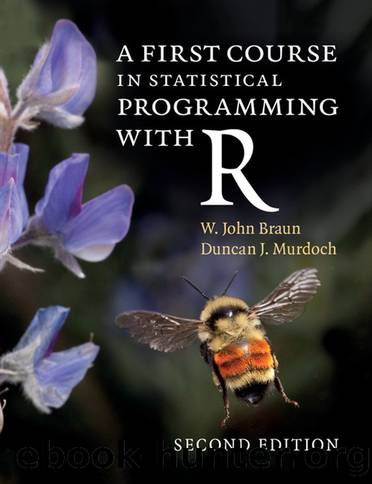First Course in Statistical Programming With R (9781316715529) by Braun W. John; Murdoch Duncan J. & Duncan J. Murdoch

Author:Braun, W. John; Murdoch, Duncan J. & Duncan J. Murdoch
Language: eng
Format: epub
Publisher: Cambridge Univ Pr
Published: 2016-06-16T16:00:00+00:00
Exercises
1 Compute 10!, 50!, 100!, and 1000!.
2
(a)Using fix() and factorial(), create a function which computes the binomial coefficient
(b)Compute , , and .
(c)The sum() function can be used to sum up all elements of its argument, while the log() and exp() functions take the natural logarithm and exponential of all elements in their argument. Use these functions to create an improved function to compute binomial coefficients.
(d)Compute , , and using the improved version.
3 Refer to Exercise 2 of Section 4.2.1 in which you created a function called compound.interest(). Often, the interest rate is quoted as a nominal annual rate, compounded monthly. To obtain the monthly rate, the nominal annual rate is simply divided by 12. More generally, if there are m interest conversion periods in a year, the nominal annual rate is divided by m to obtain the effective interest rate for the appropriate conversion period. (e.g. If the compounding is daily, the nominal annual rate is divided by 365.) Fix compound.interest() so that a nominal annual interest rate j and m, the number of conversion periods per year, are part of the argument. The effective rate is assigned in the body of the function. (You may delete from the argument list.)
Download
This site does not store any files on its server. We only index and link to content provided by other sites. Please contact the content providers to delete copyright contents if any and email us, we'll remove relevant links or contents immediately.
Grails in Action by Glen Smith Peter Ledbrook(9163)
Sass and Compass in Action by Wynn Netherland Nathan Weizenbaum Chris Eppstein Brandon Mathis(8808)
Azure Containers Explained by Wesley Haakman & Richard Hooper(7436)
Configuring Windows Server Hybrid Advanced Services Exam Ref AZ-801 by Chris Gill(7431)
Kotlin in Action by Dmitry Jemerov(7263)
Running Windows Containers on AWS by Marcio Morales(6978)
Microsoft 365 Identity and Services Exam Guide MS-100 by Aaron Guilmette(5397)
Microsoft Cybersecurity Architect Exam Ref SC-100 by Dwayne Natwick(5206)
Combating Crime on the Dark Web by Nearchos Nearchou(4977)
The Ruby Workshop by Akshat Paul Peter Philips Dániel Szabó and Cheyne Wallace(4665)
Management Strategies for the Cloud Revolution: How Cloud Computing Is Transforming Business and Why You Can't Afford to Be Left Behind by Charles Babcock(4525)
Python for Security and Networking - Third Edition by José Manuel Ortega(4231)
The Age of Surveillance Capitalism by Shoshana Zuboff(4209)
Learn Wireshark by Lisa Bock(4112)
The Ultimate Docker Container Book by Schenker Gabriel N.;(3885)
Learn Windows PowerShell in a Month of Lunches by Don Jones(3681)
DevSecOps in Practice with VMware Tanzu by Parth Pandit & Robert Hardt(3563)
Windows Ransomware Detection and Protection by Marius Sandbu(3540)
Blockchain Basics by Daniel Drescher(3507)
